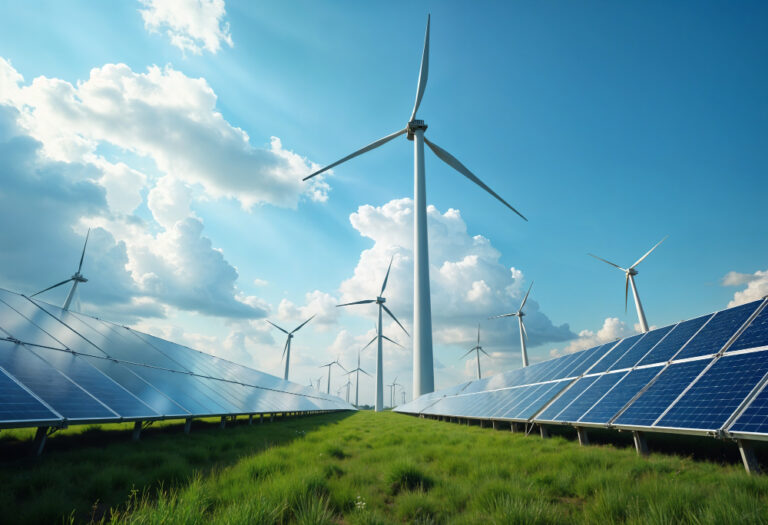Best Renewable Energy Investment Funds & ETFs for 2025 | Top Clean Energy Picks

Global investment in clean energy is set to reach $2.2 trillion in 2025, more than double the amount going into fossil fuels, according to the International Energy Agency (IEA). From solar and wind power to battery storage and low-carbon technologies, the renewable energy sector is no longer a niche—it’s becoming a dominant investment theme.
For both seasoned and beginner investors, renewable energy ETFs and mutual funds offer a way to tap into this growth while supporting the transition to a greener future. In this guide, we’ll explore the best renewable energy investment funds and ETFs for 2025, compare their performance, fees, and focus areas, and discuss the market outlook so you can make informed investment decisions.
Why Invest in Renewable Energy in 2025?
The case for renewable energy investment in 2025 is stronger than ever. Here’s why:
- Record Capacity Growth – In 2024, the world added 582 GW of renewable energy capacity, with solar leading at 452 GW and wind adding 114 GW (IRENA).
- Global Policy Momentum – While some U.S. incentives have been rolled back, Europe and Asia continue to implement stable renewable-friendly policies, attracting global capital (Financial Times).
- ESG Investment Trends – Institutional investors are under pressure to meet environmental, social, and governance (ESG) goals, making renewable funds attractive.
- Energy Security – Geopolitical tensions and volatile fossil fuel prices make renewable energy a strategic hedge.
Risks to Consider: Policy reversals, sector volatility, and supply chain bottlenecks—especially for critical materials like lithium and rare earth elements.
How to Choose the Best Renewable Energy ETFs & Funds
Not all clean energy funds are created equal. Here are the main factors to evaluate:
- Expense Ratio – Lower fees help maximize returns over time.
- Assets Under Management (AUM)—Larger AUM often means better liquidity and stability.
- Sector Focus—Some funds focus exclusively on solar or wind, while others invest broadly across renewables and related technologies.
- Geographic Exposure—Domestic vs. international exposure affects both performance and risk.
- Performance History—While past performance isn’t a guarantee, it’s still a useful benchmark.
- Sustainability Ratings – Check independent ESG scores from sources like Morningstar or MSCI.
Top Renewable Energy ETFs for 2025
Here’s a breakdown of the best-performing and most promising renewable energy ETFs for 2025, along with key stats.
1. iShares Global Clean Energy ETF (ICLN)
- Focus: Broad clean energy exposure—solar, wind, and hydro.
- Expense Ratio: ~0.41%
- AUM: $1.3–1.4B
- 2025 YTD Return: +13.88%
- Why It’s a Top Pick: Balanced portfolio with global diversification and relatively low fees. Ideal for long-term ESG-focused investors.
2. Invesco Solar ETF (TAN)
- Focus: Solar energy companies, tracking the MAC Global Solar Energy Index.
- Expense Ratio: ~0.71%
- AUM: ~$740M
- 2025 YTD Return: –14.70%
- Long-Term Performance: ~16.7% annualized over 10 years.
- Why It’s a Top Pick: Volatile but historically strong. Best suited for investors seeking concentrated solar exposure.
3. First Trust Global Wind Energy ETF (FAN)
- Focus: Wind power companies, both pure-play and diversified.
- Expense Ratio: ~0.60%
- AUM: ~$130M–$7B (projected growth)
- 2025 YTD Return: +12.66%
- Why It’s a Top Pick: Captures growth in onshore and offshore wind projects worldwide.
4. SPDR S&P Kensho Clean Power ETF (CNRG)
- Focus: AI-curated selection across solar, storage, hydrogen, and other clean power sectors.
- Expense Ratio: ~0.45%
- Why It’s a Top Pick: Uses advanced selection methodology for diversification beyond just wind and solar.
5. VanEck Low Carbon Energy ETF (SMOG)
- Focus: Low-carbon energy, including renewables, EVs, and energy storage.
- Expense Ratio: ~0.62%
- Why It’s a Top Pick: Provides exposure to the broader low-carbon transition, not just pure renewable generation.
6. ALPS Clean Energy ETF (ACES)
- Focus: U.S. and Canadian companies in clean energy sectors.
- Expense Ratio: ~0.55%
- Why It’s a Top Pick: Good for investors wanting North American exposure with a thematic ESG tilt.
ETF Comparison Table:
| ETF | Focus | Expense Ratio | 2025 YTD Return | AUM |
|---|---|---|---|---|
| ICLN | Broad clean energy | 0.41% | +13.88% | $1.3B |
| TAN | Solar-specific | 0.71% | –14.70% | $740M |
| FAN | Wind-specific | 0.60% | +12.66% | $130M+ |
| CNRG | Diversified clean power | 0.45% | TBD | TBD |
| SMOG | Low-carbon mix | 0.62% | TBD | TBD |
| ACES | NA clean energy | 0.55% | TBD | TBD |
Top Renewable Energy Mutual Funds for 2025
While ETFs dominate headlines, mutual funds remain popular with certain investors, especially those using retirement accounts.
1. New Alternatives Fund (NALFX)
- One of the oldest renewable-focused funds, active since 1982.
- Invests in wind, solar, water, and other sustainable industries.
- Strong ESG track record.
2. Calvert Global Energy Solutions Fund (CGAEX)
- Focus on clean tech and sustainable infrastructure worldwide.
- Actively managed with a balanced risk approach.
3. Guinness Atkinson Alternative Energy Fund (GAAEX)
- Mixes renewable generation with energy efficiency technologies.
- Globally diversified.
Market Outlook for Renewable Energy Investments
- Growth Drivers:
- Declining costs of solar and wind.
- Battery storage improvements.
- Electric vehicle adoption fueling renewable demand.
- Projected Expansion: BloombergNEF predicts renewable power capacity could double by 2030.
- Geographic Leaders: China and the EU are expected to lead in solar; the U.S. in offshore wind.
Risks and Challenges
- Policy Volatility: Changes in subsidies and tax credits can impact returns.
- Technology Risks: Competing innovations may disrupt existing players.
- Supply Chain Constraints: Shortages in key materials like polysilicon and lithium.
- Market Cycles: Renewable stocks can be more volatile than traditional energy sectors.
Conclusion & Action Steps
Renewable energy investment funds and ETFs offer a compelling mix of growth potential and sustainability impact in 2025.
Key Takeaways:
- For broad exposure with stability, ICLN is a strong choice.
- For sector-specific bets, TAN (solar) and FAN (wind) provide targeted growth opportunities.
- For diversified clean energy exposure, CNRG and SMOG stand out.
Action Steps for Investors:
- Assess your risk tolerance and investment horizon.
- Compare expense ratios and sector allocations.
- Consider starting with a small allocation and increasing over time.
- Review ESG ratings and sustainability metrics before committing.
Also: Renewable ETFs vs. Traditional ETFs: Which Should You Invest In for 2025 and Beyond?
FAQ
Q: Which renewable energy ETF has the best returns in 2025?
A: As of mid-2025, ICLN and FAN are leading in YTD returns among major ETFs.
Q: Is renewable energy a good investment right now?
A: Yes, especially for long-term investors who can weather short-term volatility.
Q: What’s the difference between clean energy and renewable energy ETFs?
A: Renewable ETFs focus on sources like solar and wind, while clean energy ETFs may also include nuclear, hydrogen, and other low-carbon technologies.
If you’re ready to start building a greener, more sustainable portfolio, explore one of the ETFs or mutual funds mentioned above through your brokerage account. Monitor policy changes and market trends closely—2025 could be a defining year for renewable energy investing.



